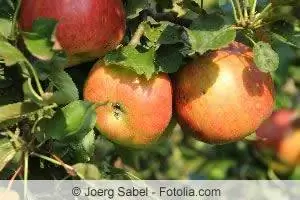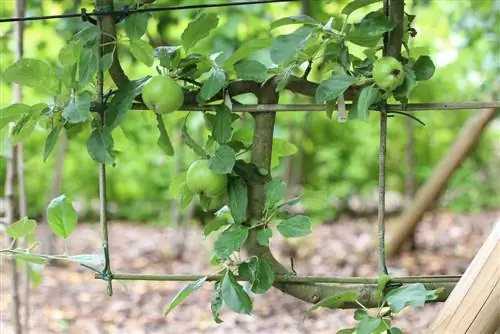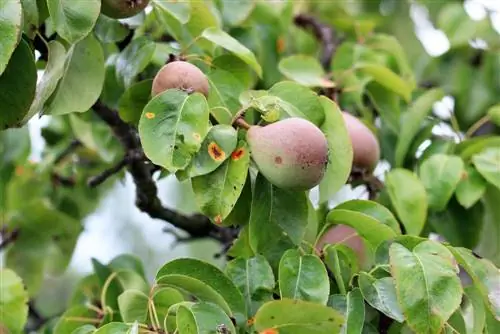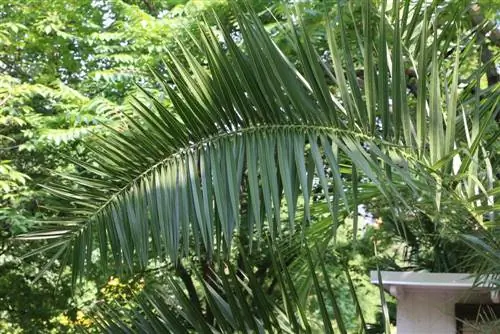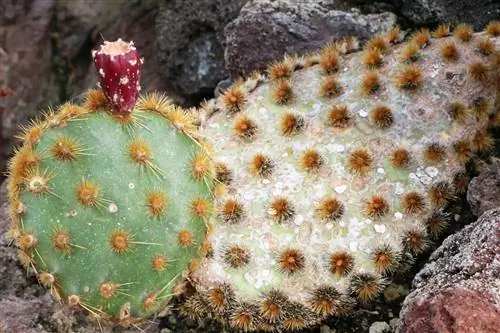- Author admin [email protected].
- Public 2023-12-17 03:39.
- Last modified 2025-06-01 06:48.
If you don't have a lot of space in the garden, only have a balcony, want to let a free wall grow over or need a privacy screen from your neighbors or the street, you can cultivate espaliered fruit from apple and pear trees. This means that the hobby gardener has an ornament in the garden all year round and can also harvest the delicious fruit in autumn. Almost all types of pears and apples are suitable as espalier fruit, so the only thing that should decide is the taste and appearance of the graceful flowers in spring.
Different types of apples
There are many tasty apple varieties, all of which can also be cultivated as espalier fruit. Only the taste of the hobby gardener decides here. Some varieties that are available are presented here:
“Gerlinde”
- medium strong, somewhat sparse growth
- high, regular returns
- Harvest between the end of August and the beginning of September
- Storage about two months
- small, round, yellow to red flamed apples, red cheeks
- sweet with fine acidity, fresh and crunchy
- hardly susceptible to mildew, not susceptible to scab
“Rebella”
- upright, broad and medium growth
- reliable harvest
- Harvest mid-September
- Storage about two months
- medium to large, elongated round yellow fruit with red cheeks
- fruity, sour-sweet taste
- not susceptible to mildew, fire blight and scab, hardly susceptible to spider mites
- very frost hardy
“Resi”
- growing weakly
- provides a high harvest
- ripe fruits at the end of September
- can be stored until January
- round, medium-sized, bright red fruits
- juicy-sweet with a strong aroma
- Not susceptible to fire blight and scab, little susceptible to spider mites and mildew
“Florina”
- strong and bulky
- provides a high harvest
- Fruits can be stored from the end of October
- good and long shelf life
- green-yellow, medium-sized fruits with purple cheeks
- sweet, juicy and firm
- not susceptible to scab, less susceptible to shell browning, fire blight and mildew
“Alkmene”
- medium growth
- Harvest varies from year to year
- early harvest from the beginning of September
- not storable
- small to medium, yellow to crimson fruits
- aromatic, taste reminiscent of “Cox Orange”
- susceptible to scab, otherwise very robust
“Beautiful man from Boskoop”
- strong growth, very branched
- high harvest, but can fluctuate
- Harvest in early November
- can be stored until April
- large, irregular, round yellow-green to red fruits
- very sour, aromatic and firm, ideal for apple pie
- does not tolerate drought, hardly susceptible to mildew and scab
- Flowers are at risk from late frost
“Kaiser Wilhelm”
- strongly growing and loosely branched
- Harvest yield fluctuates slightly, usually very high
- Harvest in October
- long shelf life until March
- mostly large, rounded, yellow-green and reddish colored fruits
- Aroma sour, reminiscent of raspberries, after long storage the firm flesh becomes slightly crumbly
- hardly susceptible to mildew and scab
“Goldparmäne”
- medium growth
- Harvest early and very high
- Harvest in September
- can be stored until January
- small or medium-sized, round to oval, yellow-orange-red fruits
- fruity, sweet and sour, slight nutty taste, a little crumbly after storage
- hardly susceptible to mildew and scab, slightly susceptible to canker infestation and blood louse
“Brettacher”
- medium growth with a tendency to baldness
- high crop yield
- Harvest at the end of October
- very well storable
- yellowish-white, red-cheeked large fruits
- fruity, tart and fresh, juicy even when stored for a long time
- less susceptible to mildew or scab
Different types of pears
Just as with apple trees, it also applies to pears that every hobby gardener has to decide for themselves which type of pear they like best. Almost all pear trees can also be grown as espalier fruit in small areas and even in pots on the balcony. Here is a small selection of tasty pears:
“Williams Christ”
- Harvest from the end of August
- cannot be stored, becomes doughy quickly
- light green to brownish large fruits
- juicy and noble aroma
- good for cooking
- can be preserved by boiling
“Gellert’s Butter Pear”
- Harvest between September and October
- brownish-green, medium-sized fruits
- very aromatic
- is suitable for fresh consumption as well as for preserving
- likes warm, south-facing trellises
“Deliciousness of Charneu”
- Harvest between October and November
- green, medium-sized fruits with slightly reddish shimmering cheeks
- juicy and sweet, very tasty
- good for fresh consumption
- very productive, especially on a trellis on the south side
“Alexander Lukas”
- Harvest time between September and mid-November
- green, large fruits
- sweet and semi-melting
- rich harvest
- early blooming, be careful of late frost
“Countess of Paris”
- Harvest in October
- Storage 6 - 8 weeks, then ready for consumption
- can be stored well into January
- yellow-green small fruits
- melting, sweet taste
- is good for fresh consumption, also suitable for cooking
- early blooming, be careful of late frost
- ideal location on a south-facing trellis
“Good Luise”
- Harvest between September to mid-October
- yellow-green fruits with red cheeks, can also change to red overall, medium size
- melting, juicy and aromatic
- very suitable for fresh consumption
- prefers a trellis on a south side
“Conference”
- Harvest between September and October
- very large, rich green fruits, often with brown spots
- melting, juicy and aromatic
- used in the kitchen as well as as fruit for direct consumption
- high harvest guaranteed
“Harrow Sweet”
- Harvest between September and November
- large, pale, green fruits
- very sweet, firm and juicy
- is ideal for direct, fresh consumption
- slightly susceptible to mildew and scab
“Clapp’s Darling”
- Harvest very early in the year in August
- bright red, shiny, medium-sized fruits
- melty, juicy and sweet
- becomes doughy quickly, can be stored for about 10-12 days, therefore fresh consumption
- ideally cultivated on a south or east-facing trellis
Prepare the trellis
The espaliers must be prepared before planting the small trees. They can have very different structures. They can be made of wood or metal, but tension wires can also be used here. Ready-made trellises are ideally purchased from a specialist store. The assembly is as shown below:
- Determine the desired length for the espalier fruit
- Set up the trellis along its entire length
- the distance between wires or rods should be about 40 cm
- Cultivation is also possible on the balcony in one or more pots
- If placed on a house wall, there must be a little space between the trellis and the wall
- this is important for good ventilation of the leaves of the trees
Tip:
Especially in areas with damp weather, it is advisable to use metal instead of wood, as a trellis made of wood weathers more quickly and therefore needs to be replaced more often than one made of metal or wire. However, especially when the trees have been growing on the trellis for a long time, it is not easy to replace rotten struts.
Plants
In many well-run garden centers or tree nurseries, small apple or pear trees can be purchased that have already been grown for espalier fruit purposes. Depending on the desired growth, the one-armed and the two-armed espalier tree as well as the U-espalier are offered here. Otherwise, the following should be taken into account when planting:
- Planting time between October and March on frost-free days
- Dig a planting hole that is twice the size of the root
- Loosen the soil well all around
- Pour compost into the planting hole or mix excavated soil with fertilizer
- Make sure there is enough space between the planting holes, depending on the desired height and width of the trees
- Place the tree in the hole and add soil, press lightly and water
Tip:
Espaliered fruit can be free-standing, but if grown on a warm, south-facing house wall, this can increase the yield of the fruit.
Conclusion
Trellis fruit from apple or pear trees fits into even the smallest corner of a garden and what could be nicer than being able to harvest your own fruit in autumn. Almost all varieties of the tasty apple and pear varieties are suitable as espalier fruit, but the care is a little more complex because the branches have to be tied along a trellis so that they do not grow in a round width, but in a parallel shape. These trees also need to be pruned more often per year than is the case with simply grown fruit trees. Otherwise, espaliered fruit is just as easy to care for as all other fruit trees and is therefore an asset to any garden if an unsightly house wall is to be covered or a privacy screen from the neighboring garden is to be created.

